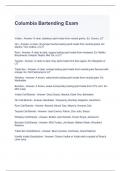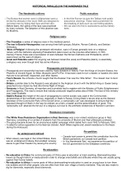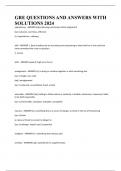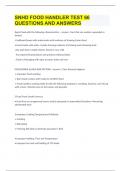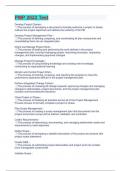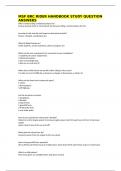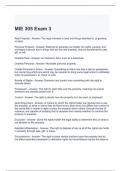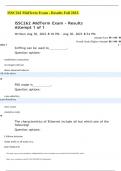Summary
MPBD summary neurodegenerative diseases
- Course
- Institution
This document contains a summary of all the lectures about neurodegenerative diseases (dementia, prion diseases, 100+ study, stem cell technology, etc).
[Show more]Some examples from this set of practice questions
1.
What does protein quality control do?
Answer: This is a process that tries to prevent the formation of aggregates.
2.
How does the hsp70 cycle work?
Answer: Hsp70 can recognize hydrophobic amino acids on a protein’s surface. Aided by a set of other proteins, ATP-bound hsp70 molecules grasp their target protein and hydrolyse ATP to ADP, undergoing conformational changes that cause the hsp70 molecules to bind even more thightly to the target. After the other protein dissociates the rebinding of ATP induces the dissociation of hsp70 after ADP release. Repeated cycles of binding and release help the target protein to refold.
3.
How does the proteasome degrade unfolded proteins that are tagged with ubiquitin?
Answer: The proteasome consists of a catalytic chamber with proteolytic acids that can degrade the proteins. Though when a protein is already aggregated it cannot enter the chamber.
4.
Why do aggregates form?
Answer: Sometimes there is an overexpression of proteins that causes them to accumulate. Sometimes there is a mutation in the protein, but also cellular stress and ageing contribute to the formation of aggregates.
5.
What is Huntington’s disease?
Answer: This is a disease with a genetic cause. The disease causes aggregates of Huntingtin proteins in the basal ganglia (which is involved in movement). The abnormal movements are caused by overactivity of dopamine in the areas in the brain that are involved in controlled movement. These aggregates form due to lengthy repeats (CAG) in the genes.
6.
Why is it safer to have bigger aggregates?
Answer: Research has shown that small oligomeric species are the most toxic, for this reason it might be safer to clump all the proteins together to protect the cell when the cell is going to divide. This way one cell will end up with one huge clump and the other cell will have no aggregates.
7.
What does mitotic clearance mean?
Answer: When cells are dividing and one of the cells contains an inclusion body (huge protein aggregate) only one of the daughter cells will end up with the inclusion body. This cell will eventually die and you would have one cell that is cleared from this aggregate. Sadly, this process does not apply to neurons since they do not divide.
8.
What response to misfolded proteins takes place in the cytosol and how does it work?
Answer: heat shock factor 1 (hsf1) is present in the cytosol and is complexed with chaperones such as hsp70, and hsp90. When this complex binds to a misfolded protein it cannot trimerize. So, when hsf1 binds to hsp70 it keeps the protein in an inactive state. When there is accumulation of unfolded proteins hsp70 binds to these proteins instead of hsf1, which causes hsf1 to trimerize. This upregulates transcription of chaperones and uniquitin.
9.
What response to misfolded proteins takes place in the ER and how does it work?
Answer: In the membrane of the ER are 3 proteins for hsf1 present. These proteins are bound by an hsp70 chaperone called BiP. Hsp70 keeps these 3 stress sensors inactive, but when there is an accumulation BiP dissociates and binds to unfolded proteins. This means that when the sensors are activated the 3 pathways of the UPR response are getting activated.
10.
What cells in the brain are activated during an inflammation response?
Answer: Microglia and astrocytes. Astrocytes have a defensive reaction aiming at handling of acute stress, limiting tissue damage, and restoring homeostasis. In severe astrogliosis the astrocytes can form a barrier around the damaged tissue, this is called an astrocytic scar. After a while, the inflammation can become chronic which increases proinflammatory cytokines, and ROS production, and impairs phagocytosis. Also, the microglia are overactive and start damaging the neurons. Microglia are activated by a process called priming. A study showed that microglia get primed with age.

Stuvia customers have reviewed more than 700,000 summaries. This how you know that you are buying the best documents.

You can quickly pay through credit card or Stuvia-credit for the summaries. There is no membership needed.

Your fellow students write the study notes themselves, which is why the documents are always reliable and up-to-date. This ensures you quickly get to the core!
You get a PDF, available immediately after your purchase. The purchased document is accessible anytime, anywhere and indefinitely through your profile.
Our satisfaction guarantee ensures that you always find a study document that suits you well. You fill out a form, and our customer service team takes care of the rest.
Stuvia is a marketplace, so you are not buying this document from us, but from seller Jylan13. Stuvia facilitates payment to the seller.
No, you only buy these notes for $6.72. You're not tied to anything after your purchase.
4.6 stars on Google & Trustpilot (+1000 reviews)
65040 documents were sold in the last 30 days
Founded in 2010, the go-to place to buy study notes for 15 years now
